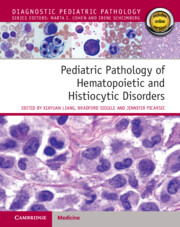Book contents
- Pediatric Pathology of Hematopoietic and Histiocytic Disorders
- Pediatric Pathology of Hematopoietic and Histiocytic Disorders
- Copyright page
- Epigraph
- Contents
- Contributors
- Section I General Hematology and Hematopathology
- Section II Non-Neoplastic Hematologic Disorders of Blood and Bone Marrow
- Section III Non-Neoplastic Disorders of Extramedullary Lymphoid Tissues
- Section IV Neoplastic Disorders of Bone Marrow
- Chapter 9 Ancillary Tests
- Chapter 10 Juvenile Myelomonocytic Leukemia (JMML)
- Chapter 11 Myeloid/Lymphoid Neoplasms with Eosinophilia and Gene Rearrangement
- Chapter 12 Myeloproliferative Neoplasms (MPNs)
- Chapter 13 Childhood Myelodysplastic Syndromes (MDSs)
- Chapter 14 Acute Myeloid Leukemia with Related Precursor Neoplasms
- Chapter 15 Myeloid Neoplasms with Germline Predisposition
- Chapter 16 Blastic Plasmacytoid Dendritic Cell Neoplasms (BPDCNs)
- Chapter 17 Acute Leukemia of Ambiguous Lineage
- Chapter 18 Precursor Lymphoid Neoplasms
- Chapter 19 Solid Tumor Metastasis to the Bone Marrow
- Section V Mature Lymphoid Neoplasms
- Section VI Histiocytic Disorders and Neoplasms
- Index
- References
Chapter 16 - Blastic Plasmacytoid Dendritic Cell Neoplasms (BPDCNs)
from Section IV - Neoplastic Disorders of Bone Marrow
Published online by Cambridge University Press: 25 January 2024
- Pediatric Pathology of Hematopoietic and Histiocytic Disorders
- Pediatric Pathology of Hematopoietic and Histiocytic Disorders
- Copyright page
- Epigraph
- Contents
- Contributors
- Section I General Hematology and Hematopathology
- Section II Non-Neoplastic Hematologic Disorders of Blood and Bone Marrow
- Section III Non-Neoplastic Disorders of Extramedullary Lymphoid Tissues
- Section IV Neoplastic Disorders of Bone Marrow
- Chapter 9 Ancillary Tests
- Chapter 10 Juvenile Myelomonocytic Leukemia (JMML)
- Chapter 11 Myeloid/Lymphoid Neoplasms with Eosinophilia and Gene Rearrangement
- Chapter 12 Myeloproliferative Neoplasms (MPNs)
- Chapter 13 Childhood Myelodysplastic Syndromes (MDSs)
- Chapter 14 Acute Myeloid Leukemia with Related Precursor Neoplasms
- Chapter 15 Myeloid Neoplasms with Germline Predisposition
- Chapter 16 Blastic Plasmacytoid Dendritic Cell Neoplasms (BPDCNs)
- Chapter 17 Acute Leukemia of Ambiguous Lineage
- Chapter 18 Precursor Lymphoid Neoplasms
- Chapter 19 Solid Tumor Metastasis to the Bone Marrow
- Section V Mature Lymphoid Neoplasms
- Section VI Histiocytic Disorders and Neoplasms
- Index
- References
Summary
Blastic plasmacytoid dendritic cell neoplasms (BPDCNs) are an aggressive hematopoietic malignancy derived from precursors to plasmacytoid dendritic neoplasms, with a predilection toward involvement of the skin, bone marrow, and peripheral blood.1
- Type
- Chapter
- Information
- Pediatric Pathology of Hematopoietic and Histiocytic Disorders , pp. 196 - 198Publisher: Cambridge University PressPrint publication year: 2024



